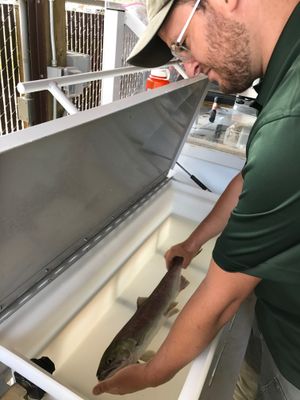Sockeye trickling upstream 900 miles from ocean to Idaho’s Stanley Basin
FISHERIES -- About 150 sockeye salmon are expected to make the epic 900-mile journey from the Pacific Ocean upstream past eight dams to Idaho's Stanley Basin this season, down from 595 last year.
The numbers are low but Idaho Fish and Game fisheries managers are optimistic that better river conditions in the past two years will improve returns starting next year.
Here's a status report from last week by Idaho Fish and Game.
The first sockeye of the year recently arrived in the Stanley Basin, including a naturally produced fish on July 27 and a hatchery fish on Aug. 2. The fish completed a 900-mile journey that included passing through eight dams and swimming 6,500 vertical feet in elevation from the Pacific to Stanley.
Through Aug. 2, 225 sockeye have crossed Lower Granite Dam about 30 miles downstream from Lewiston. That’s the last dam salmon cross before reaching Idaho, and after crossing it, the fish still have to swim another 400 miles to return to their spawning grounds in the Stanley.
Fish and Game biologists are expecting about 150 fish will complete the final leg to Stanley, and they don’t expect many more fish over Lower Granite this year.
“Typically, about 95 percent of the run has passed through Lower Granite by early August,” Eagle Hatchery Manager Dan Baker said.
At the same time last year, 790 sockeye crossed Lower Granite, and 595 returned to Stanley.
While recent sockeye runs are tiny compared with other salmon runs, they’re a vast improvement over the 1990s. When Idaho sockeye were listed in 1991 under the federal Endangered Species Act, only four adult sockeye returned to the Stanley Basin. The combined annual returns from 1991-99 was 23 fish, including two years when no sockeye returned to Idaho.
Idaho has a three-prong strategy to recover sockeye. Adults returning from the ocean are collected annually in the Stanley Basin at Redfish Lake Creek and the nearby Sawtooth Fish Hatchery.
Some of those returning adults are spawned in the hatchery, and others released to spawn naturally in Redfish Lake. Fish and Game also raises and maintains a “captive broodstock” of sockeye that are spawned to augment the sockeye returning from ocean. Those three sources provided about 740,000 young sockeye that were released, or naturally migrated from Redfish Lake, during spring.
2017 has been a difficult year for all salmon and steelhead with nearly all adult returns running below average. The one bright spot has been fall chinook, which is showing strong returns, but still smaller than last year.
Biologists hope the large snowpack from the 2016-17 winter improved out-migrating conditions for young salmon and steelhead, and a cooler ocean improved food and habitat in the Pacific that will boost future salmon and steelhead returns to Idaho.

